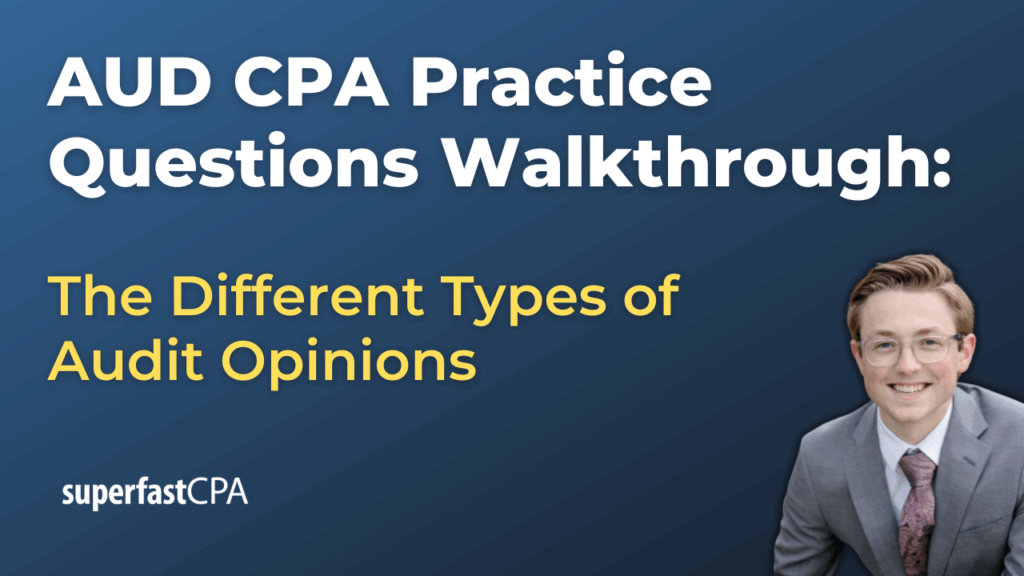In this video, we walk through 5 AUD practice questions teaching about the different types of audit opinions. These questions are from AUD content area 4 on the AICPA CPA exam blueprints: Forming Conclusions and Reporting
The best way to use this video is to pause each time we get to a new question in the video, and then make your own attempt at the question before watching us go through it.
Also be sure to watch one of our free webinars on the 6 “key ingredients” to an extremely effective & efficient CPA study process here…
The Different Types of Audit Opinions
Auditors assess whether financial statements are presented fairly in accordance with the applicable financial reporting framework, such as GAAP. Based on their findings, they issue one of four standard types of opinions: unmodified (or unqualified), qualified, adverse, or a disclaimer of opinion. The type of opinion depends on the nature and severity of any misstatements or audit limitations encountered.
This overview summarizes what each type of opinion means, the circumstances that lead to them, and examples to reinforce the key points.
Unmodified and Unqualified Opinions
A clean opinion—called an unmodified opinion for nonissuers (private companies) and an unqualified opinion for issuers (public companies)—is issued when the financial statements are materially correct and the audit is conducted without restrictions.
Example: The auditor of Maple & Co., a nonissuer, finds that the financial statements are fairly presented in accordance with GAAP. There are no material misstatements or scope limitations. An unmodified opinion is issued.
In rare cases, an unmodified opinion can still be issued even when there is a GAAP departure, if following GAAP would result in misleading financial statements. In such cases, the auditor adds an explanatory paragraph to explain the justified departure.
Qualified Opinion
A qualified opinion is appropriate when the auditor identifies a material issue—either a misstatement or a scope limitation—that is not pervasive to the overall financial statements.
Example 1: The client improperly capitalizes certain administrative expenses, leading to a material overstatement of inventory. Since the misstatement is isolated, the auditor issues a qualified opinion.
Example 2: The auditor is denied access to shipping records for a small warehouse. The scope limitation is material but limited in effect, so the auditor issues a qualified opinion.
Adverse Opinion
An adverse opinion is issued when the auditor concludes that the financial statements are materially misstated and the misstatements are pervasive—affecting multiple areas or the financial statements as a whole.
Example: A company fails to consolidate a major subsidiary, causing significant distortions in assets, liabilities, and income. Because the misstatement affects several line items and overall financial reliability, the auditor issues an adverse opinion.
Another example: A company recognizes revenue prematurely across multiple contracts, overstating income, accounts receivable, and retained earnings. The auditor concludes that the statements are misleading in total and issues an adverse opinion.
Disclaimer of Opinion
A disclaimer of opinion is issued when the auditor is unable to obtain sufficient appropriate audit evidence and the potential effects of this limitation are material and pervasive. In such cases, the auditor does not express an opinion.
Example 1: The auditor is appointed after year-end and is unable to observe the inventory count. No reliable records exist, and no alternative procedures are possible. Inventory is a significant component of the financials, so a disclaimer is issued.
Example 2: Management refuses to provide access to legal correspondence related to several lawsuits and blocks the auditor from communicating with external legal counsel. Since the possible financial impact is significant and unknown, the auditor issues a disclaimer of opinion.
Summary of Key Points
- Unmodified/Unqualified Opinion: Issued when financial statements are presented fairly and there are no material misstatements or scope limitations.
- Qualified Opinion: Issued for a material misstatement or scope limitation that is not pervasive.
- Adverse Opinion: Issued when the financial statements contain material and pervasive misstatements.
- Disclaimer of Opinion: Issued when the auditor cannot obtain sufficient appropriate audit evidence and the possible effects are material and pervasive.
This breakdown helps clarify how auditors assess audit evidence and determine which opinion best communicates the reliability of a company’s financial statements.













